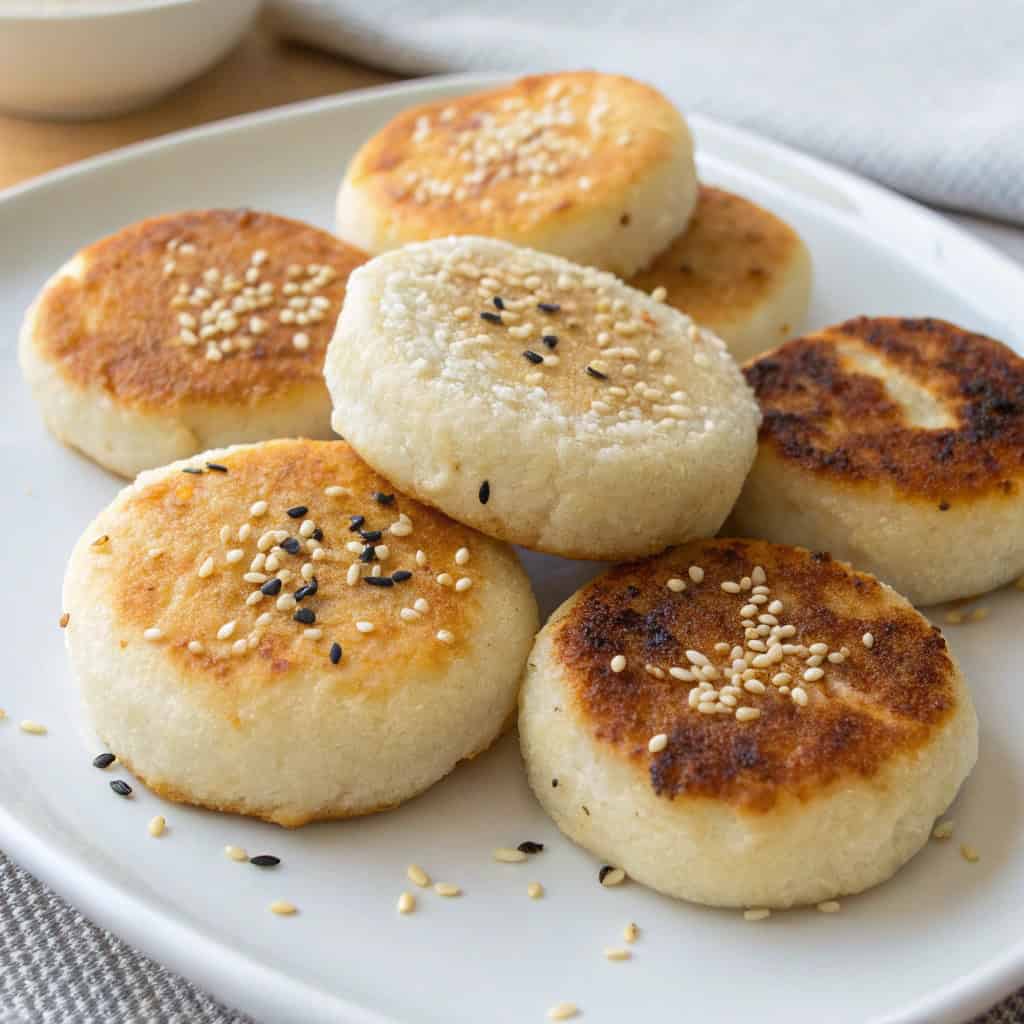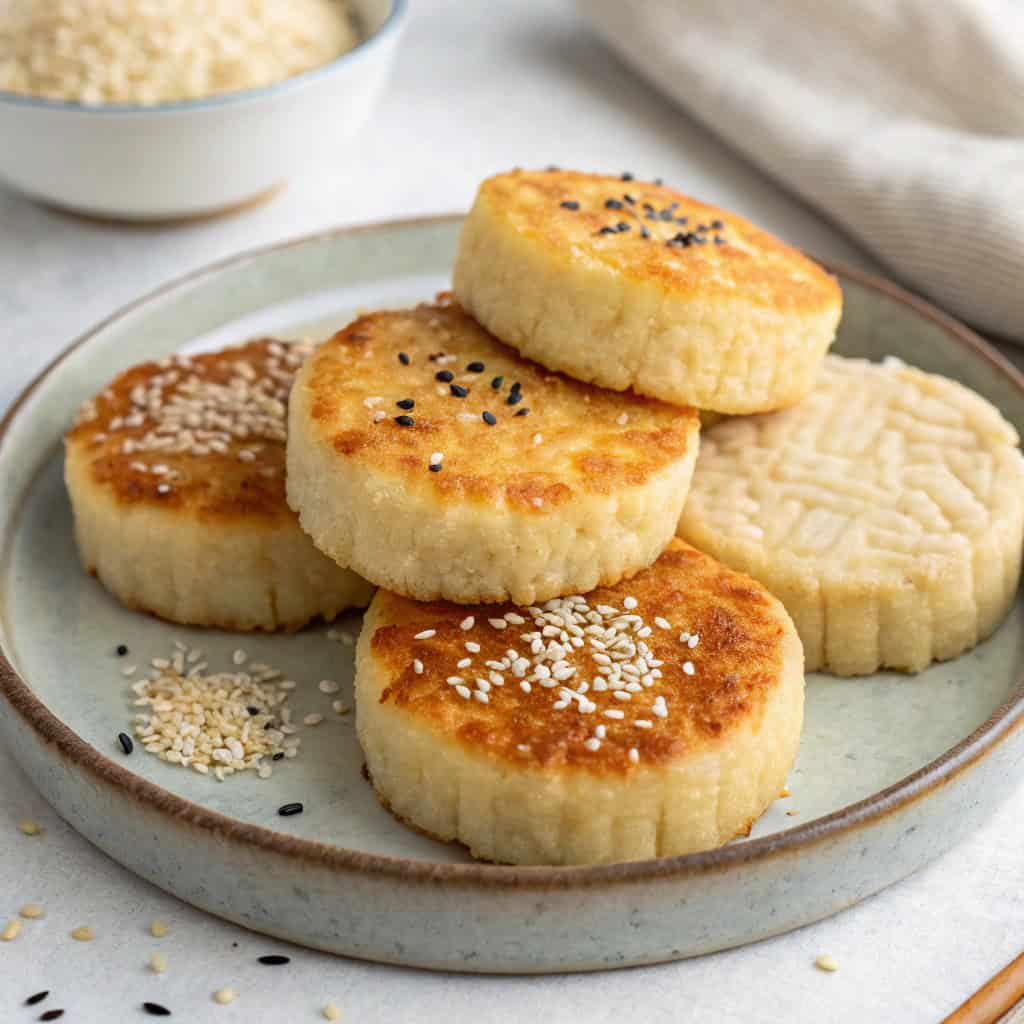Rice cakes, a beloved snack across the globe, are more than just a quick, crunchy bite. They embody versatility, simplicity, and creativity, making them a popular choice for healthy eating enthusiasts and food adventurers alike. From their cultural roots to their modern interpretations, rice cakes offer something for everyone—whether you’re seeking a light snack, a fitness-friendly treat, or a base for bold culinary creations.
This guide dives deep into the world of rice cakes, exploring their origins, types, and benefits. You’ll also find tips for making them at home, creative ways to enjoy them, and answers to some common questions. Let’s start with the basics to understand what makes rice cakes so special.
Table of Contents
What Are Rice Cakes? An Overview
The Origins
They have been around for centuries, with their roots deeply embedded in the culinary traditions of many cultures. In Asia, Korean tteok and Japanese mochi showcase the chewy side of rice cakes, while Western-style rice cakes gained popularity in the 20th century for their light, airy texture. Their creation stems from one simple idea: to transform rice into a portable and versatile food. Whether puffed, steamed, or baked, rice cakes reflect the ingenuity of turning a humble grain into something extraordinary.
Varieties Around the World
Did you know that they vary greatly depending on where you are? In Korea, you’ll find chewy, glutinous ones used in soups and desserts, while in Southeast Asia, sweet varieties often include ingredients like coconut and palm sugar. Meanwhile, the Western take on rice cakes—those round, crispy discs—serves as a convenient snack base for endless toppings. This diversity shows just how universal and adaptable rice cakes can be.
Nutritional Benefits
When it comes to health benefits, rice cakes are a low-calorie, gluten-free option that appeals to many. Made primarily from rice and often containing no additives, they’re a blank canvas for nutritious toppings. Brown rice cakes, in particular, boast added fiber, vitamins, and minerals, making them a better choice for those seeking whole-grain goodness. While they’re not inherently high in protein or fat, pairing them with nutrient-dense spreads or toppings can create a balanced, satisfying snack.
Types of Rice Cakes and Their Characteristics
Crunchy vs. Chewy Rice Cakes: A Texture Comparison
When it comes to them, texture is everything. Crunchy ones, often associated with Western-style varieties, are light and airy, made by puffing rice grains under high pressure. They’re perfect for those who crave a crispy snack with minimal calories. On the other hand, chewy ones, common in Asian cuisines, are dense and satisfying. Korean tteok and Japanese mochi are prime examples of this category. These chewy delights are often steamed or pounded, giving them a stretchy, almost bouncy texture. Both styles have their unique charm, catering to vastly different taste buds.
Brown Rice Cakes vs. White Rice Cakes
The debate between brown and white rice cakes isn’t just about taste; it’s about nutrition too. Brown ones, made from whole-grain rice, are rich in fiber and nutrients. They have a slightly nuttier flavor, making them a wholesome option for health-conscious snackers. White ones, on the other hand, are milder and softer in taste, perfect for those who prefer a more neutral base. Regardless of your choice, both types of rice cakes are naturally gluten-free and low in fat, making them a go-to snack for many.
Sweet and Savory Variations of Rice Cakes
They come in countless sweet and savory flavors, ensuring there’s something for every palate. Sweet rice cakes often include ingredients like honey, cinnamon, or fruit toppings, making them a delightful dessert or quick energy booster. Meanwhile, savory varieties can be paired with avocado, hummus, or smoked salmon for a more robust snack. This versatility is what makes rice cakes a staple in kitchens worldwide.
How to Make Them at Home
Essential Ingredients for Homemade Rice Cakes
Making them at home is easier than you might think, requiring just a few ingredients. For traditional rice cakes, you’ll need rice (sticky or non-sticky, depending on the type), water, and a pinch of salt. For puffed rice cakes, additional equipment like a press or mold may be necessary. The beauty of homemade rice cakes lies in their customizability—you can adjust the ingredients to suit your taste and dietary preferences.
Step-by-Step Recipe for Traditional Rice Cakes
Ready to make your own rice cakes? Start by washing and soaking rice to ensure the perfect texture. If you’re making chewy rice cakes, steam the soaked rice until it’s soft, then pound it into a sticky dough. For puffed ones, cook the rice, shape it into small discs, and heat them under pressure until they puff up. While the process may vary slightly depending on the recipe, the end result is always worth the effort.
Modern Methods Using Rice Flour and Shortcuts
If you’re short on time, using rice flour is a fantastic alternative. Simply mix rice flour with water to form a batter, then steam or bake it into them. This method is quicker and often results in a smoother texture. Some modern gadgets, like rice cake makers, take the guesswork out of the process entirely, allowing you to enjoy freshly made them with minimal effort.
Creative Ways to Enjoy Them
Sweet Toppings for a Healthy Treat
They are the perfect base for sweet snacks, offering endless possibilities for toppings. A classic option is spreading peanut butter and adding sliced bananas or strawberries, a combination that’s both nutritious and satisfying. You could also drizzle honey and sprinkle some cinnamon for a simple yet flavorful twist. If you’re feeling adventurous, try a layer of Greek yogurt with a handful of granola or chopped nuts for added crunch. They make an excellent guilt-free dessert when paired with these wholesome ingredients.
Savory Toppings for a Protein-Packed Snack
If you’re in the mood for something savory, they can be transformed into a protein-packed snack. Spread avocado and top it with a poached egg for a breakfast option that’s both delicious and nutritious. For lunch or dinner, pair your rice cake with hummus, cucumber slices, and a sprinkle of paprika. You could even add smoked salmon, cream cheese, and capers for a more indulgent take. These toppings not only elevate the humble rice cake but also keep you feeling full longer.
Rice Cake Meal Prep Ideas
They aren’t just for snacks—they can be part of your meal prep routine. Stack them with layers of ingredients to create a quick, portable lunch. For example, alternate slices of turkey, cheese, and lettuce between two rice cakes for a low-carb sandwich alternative. You can also crumble them into soups or salads for an extra crunch. With a little creativity, they can fit seamlessly into any meal plan.
Rice Cakes for Fitness and Nutrition
Why Athletes Love them
Athletes often turn to them as a quick and convenient energy source. Their low-fat and high-carb profile makes them ideal for pre- or post-workout snacks. Unlike many packaged snacks, they are free from artificial ingredients, making them a clean option for fueling workouts. Plus, they’re easy to digest, which is crucial for anyone engaging in intense physical activity.
Low-Calorie and Gluten-Free Options
One of the reasons they are so popular among health-conscious individuals is their low-calorie count. Most plain rice cakes have fewer than 50 calories each, making them a guilt-free choice. They’re also naturally gluten-free, which makes them suitable for people with celiac disease or gluten sensitivities. For an even healthier option, choose brown rice cakes, which offer more fiber and nutrients than their white rice counterparts.
Ideal Pairings for Post-Workout Snacks
Pairing them with the right toppings can turn them into a powerful post-workout snack. For example, top a rice cake with almond butter and a sprinkle of chia seeds to replenish energy and promote recovery. Adding sliced turkey or cottage cheese provides protein for muscle repair. These simple yet effective combinations make rice cakes a go-to option for fitness enthusiasts.
To explore more healthy recipes that complement rice cakes, check out Gluten-Free Peanut Biscuits for another nutritious snack option.
Frequently Asked Questions
Are They Healthy?
Yes, They are a healthy snack when enjoyed in moderation. They’re low in calories and fat, making them ideal for weight management. Additionally, their gluten-free nature makes them suitable for people with dietary restrictions. However, it’s important to pair them with nutrient-rich toppings like nut butter, avocado, or hummus to create a balanced snack. Eating plain rice cakes without added nutrients may not keep you full for long.
How Long Do They Stay Fresh?
They have a relatively long shelf life due to their low moisture content. When stored in an airtight container in a cool, dry place, they can last several months without going stale. However, once opened, it’s best to consume them within a week or two to enjoy their crisp texture. If they lose their crunch, try popping them in a toaster oven for a quick refresh.
Can You Freeze Rice Cakes?
Freezing them isn’t common, but it’s possible. For chewy rice cakes like Korean tteok, freezing is a great way to preserve freshness. Simply store them in a freezer-safe bag and thaw them at room temperature before eating. For puffed rice cakes, freezing may affect their texture, so it’s better to store them in an airtight container at room temperature instead.
FAQs from Google’s People Also Ask Section
What Are They Good For?
Rice cakes are great for those looking for a low-calorie snack or a gluten-free alternative to bread. They’re versatile and can be used as a quick energy boost, a healthy breakfast, or a post-workout snack. With the right toppings, they can satisfy both sweet and savory cravings.
Do They Cause Weight Gain?
On their own, they are unlikely to cause weight gain due to their low-calorie content. However, the toppings you choose can make a difference. Opt for healthy spreads and ingredients like almond butter, fresh fruit, or lean proteins to keep your snack balanced and nutritious.
Are They Good for Diabetics?
They can be included in a diabetic-friendly diet, but it’s essential to monitor portion sizes. Because they have a high glycemic index, plain rice cakes can cause blood sugar spikes if eaten alone. Pairing them with protein or healthy fats, such as peanut butter or cottage cheese, can help stabilize blood sugar levels.
For another sustainable meal idea, try summer sausage recipes, which pair well with eco-conscious eating habits.
The Cultural Significance
Rice Cakes in Asian Traditions
They have a deep cultural significance in many Asian countries. In Korea, tteok is a staple during celebrations, especially during the Lunar New Year, where tteokguk (rice cake soup) symbolizes longevity and prosperity. In Japan, mochi holds similar importance during the New Year, often prepared in traditional ceremonies called mochitsuki. These chewy rice cakes are enjoyed as symbols of good fortune and community togetherness.
In Southeast Asia, they take various forms, such as the banana leaf-wrapped kueh in Malaysia or Indonesia. These sweet or savory treats are an integral part of festivals, rituals, and family gatherings, showcasing the versatility of rice as a central ingredient in local cuisines.
Modern Rice Cakes Across the Globe
In recent decades, they have gained popularity outside of Asia as a health-conscious snack. Western-style puffed rice cakes, often topped with trendy spreads like avocado or almond butter, have become a favorite for people seeking low-calorie and gluten-free options. While the cultural significance may differ, the modern rice cake continues to bridge the gap between tradition and innovation, appealing to a diverse audience worldwide.
For those who enjoy other wholesome rice-based options, consider trying creamy chicken and rice. It highlights how versatile rice can be in various dishes.
Final Thoughts and Takeaways
Why They Deserve a Spot in Your Pantry
From their historical roots to their present-day popularity, they have proven to be more than just a snack. They’re a symbol of tradition, a blank slate for culinary creativity, and a convenient, healthy option for people of all ages. Whether you’re looking to enjoy a light bite, fuel your workout, or explore global food cultures, they offer something for everyone.
Your Next Step: Explore and Experiment
Now that you know everything about them, why not try them in your kitchen? Experiment with toppings, explore different varieties, and even attempt making your own at home. Whether you prefer sweet or savory, chewy or crunchy, they are the perfect canvas for creating meals and snacks that are as nutritious as they are delicious.
In addition to these ideas, for those who crave heartier fare, explore smoked mac and cheese recipes. This dish, like these snacks, satisfies comfort food cravings.
For more creative ways to enjoy rice cakes and discover delicious topping ideas, check out the inspiring recipes on AllRecipes. From sweet combinations to savory innovations, you’ll find plenty of ideas to elevate your rice cake game!


